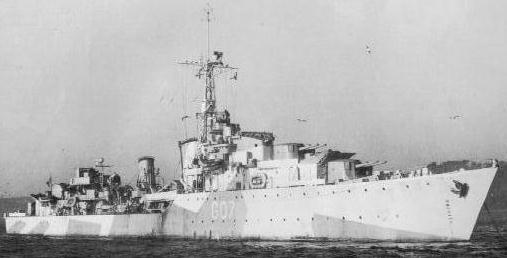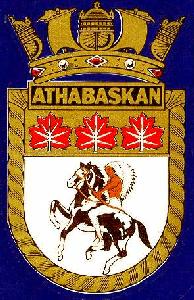The first two ships were laid down as IROQUOIS and ATHABASKAN
but IROQUOIS was delayed by bombing while on the stocks. ATHABASKAN was
therefore renamed IROQUOIS and launched as the lead ship while the original
IROQUOIS was launched as ATHABASKAN. After her commissioning on 3rd February
1943 at Newcastle-on-Tyne, she was assigned to the British Home Fleet but
ATHABASKAN was plagued with mishaps during her very short service life.
The ship left on 29th March 1943 to patrol the Iceland-Faeroes Passage
for blockade runners. Weather induced stress caused hull damage This took
five weeks to repair at South Shields, U.K. In June 1943, ATHABASKAN took
part in Operation Gearbox III, the relief of the garrison at Spitsbergen.
On June 18, she collided with the boom defence vessel BARGATE at Scapa
Flow, resulting in a month of repairs at Devonport. In July and August
of 1943, she was based in Plymouth, carrying out anti-submarine patrols
in the Bay of Biscay and on August 27 was hit by a glider bomb off the
Spanish coast. She managed to reach Devonport where she remained under
repair until November 10.
Returning to Scapa Flow in December, she escorted convoy JW55A to
Russia but in February 1944, rejoined Plymouth command and was assigned
to the newly formed 10th Destroyer Flotilla. On 26th April, she assisted
in the destruction of the German torpedo boat T 29 in the Channel off Ushant
and three days later on 29th April, was sunk by a torpedo from T24, an
Elbing class destroyer, north of the Ile de Bas. Her Captain, John Stubbs
and 128 men were lost, 83 taken prisoner and 44 rescued by HAIDA.


